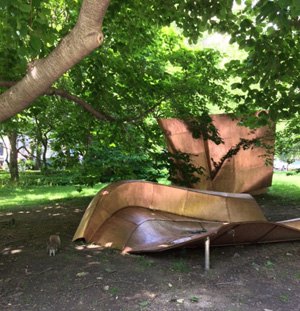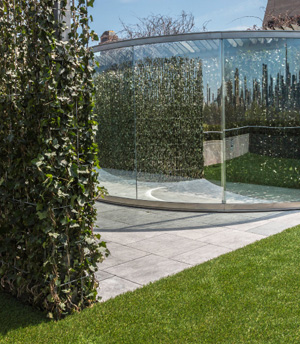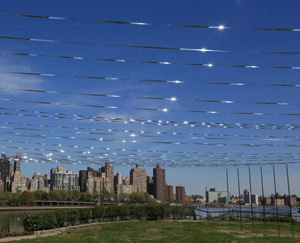From Liberty to Luxury
John Haberin New York City
Summer Sculpture 2014: Danh Vo and Dan Graham
Summer in New York brings sculpture in the parks, as one more reason to head outdoors. So again this year, head out with me—on a walk from City Hall Park across the bridge to Brooklyn, for Danh Vo. From there, I head to the Met roof for Dan Graham and to Socrates Sculpture Park, for the most monumental and yet ephemeral sculpture of all.
Taking liberties
This summer has also brought the opening of a museum at Ground Zero—and the opening of the National September 11 Memorial to all, without tickets or checkpoints. It brings a populist mayor to Gracie Mansion.  And it brings the departure of the art fairs, for a while. While only the museum was behind schedule, the rest deserve at least as much the qualifier "at last." So how about sculpture that aspires at once to be monumental, populist, contemporary, and distinctly American? How about, in fact, the Statue of Liberty?
And it brings the departure of the art fairs, for a while. While only the museum was behind schedule, the rest deserve at least as much the qualifier "at last." So how about sculpture that aspires at once to be monumental, populist, contemporary, and distinctly American? How about, in fact, the Statue of Liberty?
Danh Vo has spent four years recreating its skin, bit by bit and to scale, in copper without the patina of oxidation and time. Now he brings some fifty pieces to New York, at least one with a view of Liberty Island. And even those amount less than a fifth of the whole. We the People offers a populist slant right in its title, the opening words of the Constitution, while resting amid waterfront renewal—or, if you will, gentrification. Is that a contradiction? The whole work takes the form of a puzzle.
Make that a jigsaw puzzle, with the challenge of guessing what goes where. A towering canopy in Brooklyn Bridge Park drapes the statue's shoulder, and a piece nearby serves as its ear. Plaques for more in City Hall Park supply the answers, with shading out of a "paint by numbers" kit. They also note that the statue's base echoes Minimalism, a movement that took sculpture off its pedestal. A philosopher might call the work of disassembly, recreation, and dispersal an act of deconstruction. Where Frédéric Auguste Bartholdi sought classical models for a gift from France to America, Vo's replica was "conceived in Germany, fabricated in Shanghai, supported by his French gallery, in collections and art institutions worldwide, and dispersed to exhibition venues in more than fifteen countries."
Born in Vietnam, Vo considers himself Danish and adds flowers modeled after Victorian gardening. Is immigration, then, no more than a displacement? Is the work a critique of capitalism and the art world—or an affirmation of the American dream? It may never quite articulate either one, but it offers a leisurely recap of Western sculpture. A piece nestled under a tree could be a reclining nude or an airplane wing, while the canopy in Brooklyn could abstract away from the entire statue. So what if, like the green of the original, it is only skin deep?
Rachel Feinstein, too, is no stranger to another century. She calls her outdoor sculpture Folly, after the faux medieval ruins in French and English gardens. The three follies in Madison Square Park use black lines on powdery white aluminum, like sketches that an unwitting assistant sent out for casting by mistake. A house perches on a cliff over a water wheel, in the style of a children's book, and a ship flies into a tree. A stairwell leads up to a castle gate—or perhaps the proscenium arch of a stage. If everything here seems stagey, Feinstein likes it that way, lest fantasy give way to function.
Alice Aycock combines monumentality with delicacy and dispersal, on the Park Avenue median, where she gives way in midsummer to the stainless steel "implosions" of Ewerdt Hilgemann. One part of her Paper Chase spirals upward like a spinning top, and another blossoms outward like a flower. The largest lounges horizontally like a public fountain, its scale matched to the Florentine architecture of the Racquet and Tennis Club facing it. It may not nestle so easily into the plaza of the Seagram Building, with good reason: each shard of aluminum retains the lightness of cut paper. One can picture Aycock with her scissors at play.
The real Ivy League
If one is going to have a roof garden, how about a little greenery and a garden pavilion? Dan Graham supplies both for the Met roof—much as Rafael Domenech has reimagined SculptureCenter as a pavilion itself. A thick carpeting of green greets one from the moment one steps off the elevator or the stairs, as lush as Astroturf. It extends everywhere—except to a space for the pavilion itself.  Nestled between two trellised ivy walls, its glass and steel allow the Met's exquisite tiling to show through the grass.
Nestled between two trellised ivy walls, its glass and steel allow the Met's exquisite tiling to show through the grass.
Graham's surroundings appear through boundaries of his own making, and those surroundings include both the Met and Central Park. Each reflects the world and yet stands apart, much like his art. After serial museum expansions, one might call the entire park the Met's New York wing. Yet the museum still offers a solace from a restive city, and Central Park is every New Yorker's playground, as well as its most luxuriant alternative. These are not the crowded and plebian heights of the High Line, where Marianne Vitale erects railroad switches far more totemic than the rusted tracks below. Other summer sculpture there is so well integrated as to approach invisibility or an embarrassment—but not here.
One looks down from the Met roof, scans the skyline for landmarks, and settles for the high-rises that obscure them. No sculpture can compete with the view, but Graham encompasses both. He took an interest in Minimalism and urban entropy, much like Robert Smithson, before turning in the 1990s to his pavilions. Inside, the Met offers an introduction. It has snapshots of northern New Jersey, his recent Triangular Solid with Circular Cut-Outs, and a 1995 proposal for an installation in Germany. A 2009 retrospective had more, but this will do nicely.
Hedge Two-Way Mirror Walkabout is also landscape architecture, in collaboration with Günther Vogt. A steel frame encloses an S of slightly mirrored glass, more like a curved window than a device in a spy movie. One looks both outward and within. And each view comes with surprises, including oneself in reflection and others on the far side of the wall. Are they mostly taking pictures with their cell phones? Maybe the entire installation is a selfie.
A pavilion has to seem at least a little out of place. It belongs to the old-fashioned English landscaping of hedges, mazes, and a gazebo of steel and glass. Besides, it usually comes with a roof, not on one. Graham, though, relishes strangeness. Where the Met's 2013 summer sculpture by Imran Qureshi stained the tile red in memory of wars, he brings the garden upstairs. And where 2012 summer sculpture by Tomás Saraceno and 2010 summer sculpture by Doug and Mike Starn rose above, as clouds or as tree houses, he assimilates both the roof and the park below.
Guilty about all that high living? Is a garden pavilion a cheap substitute for condos on Central Park South or a metaphor for sleek office towers? Do selfies take over the show? Sure, but this maze is ever so easy to navigate, because Graham offers an escape from the maze of the everyday. His vision can be too clinical or too accepting. Yet he brings Minimalism's clarity into the air.
A patch of greenery
Sculpture in the parks is one of New York's delights. Just when many are leaving town, it invites one to explore the breadth of the city. Hey, you already wanted to leave midtown to tourists—where, if they look up, they even might catch a rendition of clouds on Fifth Avenue by the Plaza Hotel, by Olaf Breuning. Only watch out: an outdoor group show can also become either a treasure hunt or a nuisance, sometimes both at once. Did you finally stumble on everything and identify everyone, and did a patch of urban greenery remain just for you? 
For 2014 Socrates Sculpture Park sticks to just four large works, with plenty of room to climb right in or to lie in the sun. Take your pick. You can safely ignore, scorn, or marvel at the waterfront park's permanent residents—the dreary urban stereotypes of statues by Tim Rollins and K.O.S and, behind a fence, the abstract giants of Mark di Suvero, a park founder. You will find instead art tailored to the site and holding out a welcome. It includes a reminder of the city's survival, a tribute to a dedicated New Yorker, and ripples in the grass and sky. On Memorial Day weekend, dandelion tufts blew past in the light.
One expects a welcome from the "Broadway billboard" above the entrance gate, and Meschac Gaba does his best, with colors that radiate out from a central point. One might mistake them for a park logo rather than a work of art, and in fact each narrow triangle elongates a nation's flag. The Beninese artist thinks of his painting as a vision of a more harmonious world. Citoyens du Monde refers to the internationalism of a group that, starting after World War II, proclaimed its members citizens of the world. It also introduces an international summer group show. My first guess, though, was that it named the heady idealism of the French revolution, and I was worried for my head.
I might have worried, too, for the ark nearby, in vinyl siding that appears to have washed up far from the shore. Austin+Mergold call it SuralArk, as a cross between suburbia and Surrealism, but it seems reasonably urban and down to earth. Its two rows of upright two-by-fours converge at the top, where a horizontal stabilizer seems only good sense, give or take that the ship is upside-down. If thoughts of Hurricane Sandy spring to mind, the curved beams elevate the ark several feet above ground. The Philadelphia architects have painted the bottom few feet black, a projection of rising sea levels or the next Biblical flood. The vinyl canopy also suggests a refuge, although it looks bare-bones from inside.
One expects Paweł Althamer to be at least as virtuous, less than challenging, and a lot sloppier, and the Polish artist delivers. The huge assemblage of spare parts and rags represents a crowned woman lying down, one droopy arm spread out at her side. Queen Mother of Reality honors Delois Blakely, a former nun who founded the New Future Foundation, to support a student exchange program with Africa and to promote multi-ethnic understanding. She holds the honorary title of community mayor of Harlem as well, and this is Astoria, but who expects Althamer to look beyond virtues to specifics? He also has the unfortunate result of making her look like an oversized bag lady sleeping in the park. One can enter the construction for more, including Chinese lanterns and airplane seats, but do not come looking for illumination or a wild ride.
Zilvinas Kempinas, who brought (ouch) a disco floor for Governors Island in 2011, has the largest work, but also the most free to sunbathers and the imagination. Like the ark, Scarecrow banks on two rows, only of upright poles in stainless steel, and their curves lay out an arc in the grass rather than the sky. Mylar runs overhead between the rows, like more flags for citizens of Queens or the world. Sunlight dances along the tape as it moves with the wind, all the more dazzling when the breeze dies down and the motion seems to belong to the light alone. The Lithuanian artist keeps the poles far enough apart that one can easily pass into the central meadow, where the rippling of thin shadow lines in the grass can grow downright disorienting. Still, one can always look up to find a welcome—and a New York summer.

Danh Vo ran in City Hall and Brooklyn Bridge Parks through December 6, 2014, Rachel Feinstein in Madison Square Park through September 7, Alice Aycock on Park Avenue through July 20, Ewerdt Hilgemann there through November 7, Dan Graham at The Metropolitan Museum of Art through November 2, Olaf Breuning at the Plaza through August 24, and sculpture in Socrates Sculpture Park through August 3. I look separately at 2014 summer group shows in the galleries and return for summer sculpture in 2015 and again in 2016, including Katharina Grosse at Rockaway Beach, plus summer 2017, summer 2018, summer 2019, summer 2020 and its extension into fall, summer 2021, summer 2022, summer 2023, and summer 2024.




